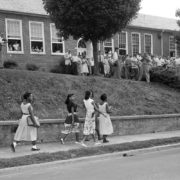Jo Ann Allen Boyce and 11 other students desegregated their high school in Clinton, Tennessee. Then the riots came.
CLINTON HIGH SCHOOL * CLINTON, TENNESSEE * 1956
The dress jo ann allen boyce had picked out for her first day of school, August 27, 1956, was beautiful: a black top and matching skirt with a pattern around the hem. Her grandmother had made it. In fact, her grandmother, a brilliant seamstress, had made Jo Ann an entire wardrobe of clothes for that first week.
Jo Ann had given herself bangs and wore her long hair down. “For some reason I thought that was a really cute hairdo,” she told me recently. She got ready and headed out the door. At Green McAdoo Elementary School, just down the road from her home in Clinton, Tennessee, she met up with nine other Black classmates, their pastor, and family members to pray.
For the two years before that late-summer Monday, her morning routine had been different. She typically rose with the sun, got dressed—in whatever felt right—and walked to catch a bus that would take her a little more than 20 miles east, first to Vine Junior High and then on to Austin High School, both in Knoxville. The bus ride usually took an hour. She felt relieved that morning because her commute was shorter, just a brief walk from her house. But her relief was temporary.
— Credits
Featured Image, Gene Herrick / AP
Full article @ The Atlantic
— Related
Jim Crow laws were state and local laws that enforced racial segregation in the Southern United States. These laws were enacted in the late 19th and early 20th centuries by white Southern Democrat-dominated state legislatures to disenfranchise and remove political and economic gains made by black people during the Reconstruction period. The Jim Crow laws were enforced until 1965.
In practice, Jim Crow laws mandated racial segregation in all public facilities in the states of the former Confederate States of America and in some others, beginning in the 1870s. Jim Crow laws were upheld in 1896 in the case of Plessy vs. Ferguson, in which the U.S. Supreme Court laid out its “separate but equal” legal doctrine for facilities for African Americans. Moreover, public education had essentially been segregated since its establishment in most of the South after the Civil War in 1861–65.
The legal principle of “separate but equal” racial segregation was extended to public facilities and transportation, including the coaches of interstate trains and buses. Facilities for African Americans were consistently inferior and underfunded compared to facilities for white Americans; sometimes, there were no facilities for the black community. As a body of law, Jim Crow institutionalized economic, educational, and social disadvantages for African Americans living in the South.
Jim Crow laws and Jim Crow state constitutional provisions mandated the segregation of public schools, public places, and public transportation, and the segregation of restrooms, restaurants, and drinking fountains between white and black people. The U.S. military was already segregated. President Woodrow Wilson, a Southern Democrat, initiated the segregation of federal workplaces in 1913.
In 1954, segregation of public schools (state-sponsored) was declared unconstitutional by the U.S. Supreme Court under Chief Justice Earl Warren in the landmark case Brown v. Board of Education. In some states, it took many years to implement this decision, while the Warren Court continued to rule against the Jim Crow laws in other cases such as Heart of Atlanta Motel, Inc. v. United States (1964). Generally, the remaining Jim Crow laws were overruled by the Civil Rights Act of 1964 and the Voting Rights Act of 1965.
Source – Jim Crow Laws (Updated: 23 August 2020) Wikipedia. Available at https://en.wikipedia.org/wiki/Jim_Crow_laws, (Accessed: 14 October 2020)

